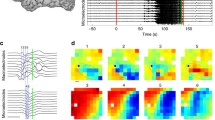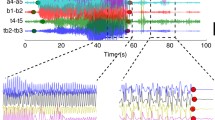Abstract
Partial epilepsy is characterized by recurrent seizures that arise from a localized pathological brain region. During the onset of partial epilepsy, the seizure evolution commonly exhibits typical timescale separation phenomenon. This timescale separation behavior can be mimicked by a paradigmatic model termed as Epileptor, which consists of coupled fast-slow neural populations via a permittivity variable. By incorporating permittivity noise into the Epileptor model, we show here that stochastic fluctuations of permittivity coupling participate in the modulation of seizure dynamics in partial epilepsy. In particular, introducing a certain level of permittivity noise can make the model produce more comparable seizure-like events that capture the temporal variability in realistic partial seizures. Furthermore, we observe that with the help of permittivity noise our stochastic Epileptor model can trigger the seizure dynamics even when it operates in the theoretical nonepileptogenic regime. These findings establish a deep mechanistic understanding on how stochastic fluctuations of permittivity coupling shape the seizure dynamics in partial epilepsy, and provide insightful biological implications.
Similar content being viewed by others
References
Talairach J, Bancaud J. Lesion, “irritative” zone and epileptogenic focus. Confin Neurol, 2004, 27: 91–94
Wang Y, Goodfellow M, Taylor P N, et al. Dynamic mechanisms of neocortical focal seizure onset. PLoS Comput Biol, 2014, 10: e1003787
Bartolomei F, Wendling F, Bellanger J J, et al. Dynamic mechanisms of neocortical focal seizure onset. PLoS Comput Biol, 2011, 112: 1746–1760
Laxer K D, Trinka E, Hirsch L J, et al. The consequences of refractory epilepsy and its treatment. Epilepsy Behav, 2014, 37: 59–70
Braakman H M H, Vaessen M J, Jansen J F A, et al. Frontal lobe connectivity and cognitive impairment in pediatric frontal lobe epilepsy. Epilepsia, 2013, 54: 446–454
Dinkelacker V, Xin X, Baulac M, et al. Interictal epileptic discharge correlates with global and frontal cognitive dysfunction in temporal lobe epilepsy. Epilepsy Behav, 2016, 62: 197–203
Liao W, Zhang Z, Pan Z, et al. Default mode network abnormalities in mesial temporal lobe epilepsy: A study combining fMRI and DTI. Hum Brain Mapp, 2011, 32: 883–895
Bartolomei F, Guye M, Wendling F. Abnormal binding and disruption in large scale networks involved in human partial seizures. EPJ Nonlinear Biomed Phys, 2013, 1: 4
Leao A A. Spreading depression of activity in the cerebral cortex. J Neurophysiol, 1944, 7: 359–390
Krishnan G P, Bazhenov M. Ionic dynamics mediate spontaneous termination of seizures and postictal depression state. J Neurosci, 2011, 31: 8870–8882
Wendling F, Bartolomei F, Bellanger J J, et al. Epileptic fast activity can be explained by a model of impaired GABAergic dendritic inhibition. Eur J Neurosci, 2002, 15: 1499–1508
Wang Y J, Goodfellow M, Taylor P N, et al. Phase space approach for modeling of epileptic dynamics. Phys Rev E, 2012, 85: 061918
Jirsa V K, Stacey W C, Quilichini P P, et al. On the nature of seizure dynamics. Brain, 2014, 137: 2210–2230
Proix T, Bartolomei F, Chauvel P, et al. Permittivity coupling across brain regions determines seizure recruitment in partial epilepsy. J Neurosci, 2014, 34: 15009–15021
El Houssaini K, Ivanov A I, Bernard C, et al. Seizures, refractory status epilepticus, and depolarization block as endogenous brain activities. Phys Rev E, 2015, 91: 010701
Destexhe A, Rudolph-Lilith M. Neuronal Noise (in English). New York: Springer Press, 2012
Gerstner W, Kistler W M. Spiking Neuron Models: Single Neurons, Populations, Plasticity. Cambridge: Cambridge University Press, 2002
Li C, Chen L, Aihara K. Transient resetting: A novel mechanism for synchrony and its biological examples. PLoS Comput Biol, 2006, 2: e103
Wang Q, Duan Z, Perc M, et al. Synchronization transitions on smallworld neuronal networks: Effects of information transmission delay and rewiring probability. Europhys Lett, 2008, 83: 50008
Wang Q, Perc M, Duan Z, et al. Delay-enhanced coherence of spiral waves in noisy Hodgkin-Huxley neuronal networks. Phys Lett A, 2008, 372: 5681–5687
Guo D, Wang Q, Perc M. Complex synchronous behavior in interneuronal networks with delayed inhibitory and fast electrical synapses. Phys Rev E, 2012, 85: 061905
Neiman A B, Yakusheva T A, Russell D F. Noise-induced transition to bursting in responses of paddlefish electroreceptor afferents. J Neurophysiol, 2007, 98: 2795–2806
Guo D, Li C. Stochastic and coherence resonance in feed-forwardloop neuronal network motifs. Phys Rev E, 2009, 79: 051921
Guo D, Li C. Signal propagation in feedforward neuronal networks with unreliable synapses. J Comput Neurosci, 2011, 30: 567–587
Guo D, Li C. Stochastic resonance in Hodgkin-Huxley neuron induced by unreliable synaptic transmission. J Theor Biol, 2012, 308: 105–114
Ma J, Wu Y, Ying H P, et al. Channel noise-induced phase transition of spiral wave in networks of Hodgkin-Huxley neurons. Chin Sci Bull, 2011, 56: 151–157
Ma J, Tang J, Zhang A H, et al. Robustness and breakup of the spiral wave in a two-dimensional lattice network of neurons. Sci China-Phys Mech Astron, 2010, 53: 672–679
Ma J, Jia Y, Tang J, et al. Breakup of spiral waves in coupled Hindmarsh-Rose neurons. Chin Phys Lett, 2008, 25: 4325–4328
Kramer M A, Truccolo W, Eden U T, et al. Human seizures selfterminate across spatial scales via a critical transition. Proc Natl Acad Sci USA, 2012, 109: 21116–21121
Takeshita D, Sato Y D, Bahar S. Transitions between multistable states as a model of epileptic seizure dynamics. Phys Rev E, 2007, 75: 051925
Prusseit J, Lehnertz K. Stochastic qualifiers of epileptic brain dynamics. Phys Rev Lett, 2007, 98: 138103
Heinemann U, Konnerth A, Pumain R, et al. Extracellular calcium and potassium concentration changes in chronic epileptic brain tissue. Adv Neurol, 1986, 44: 641–661
Suh M, Ma H, Zhao M, et al. Neurovascular coupling and oximetry during epileptic events. Mol Neurobiol, 2006, 33: 181–198
Zhao M, Nguyen J, Ma H, et al. Preictal and ictal neurovascular and metabolic coupling surrounding a seizure focus. J Neurosci, 2011, 31: 13292–13300
de Curtis M, Gnatkovsky V. Reevaluating the mechanisms of focal ictogenesis: The role of low-voltage fast activity. Epilepsia, 2009, 50: 2514–2525
Kramer M A, Cash S S. Epilepsy as a disorder of cortical network organization. Neuroscientist, 2012, 18: 360–372
Miley C E, Forster F M. Activation of partial complex seizures by hyperventilation. Archives Neurology, 1977, 34: 371–373
Şenol V, Soyuer F, Arman F, et al. Influence of fatigue, depression, and demographic, socioeconomic, and clinical variables on quality of life of patients with epilepsy. Epilepsy Behav, 2007, 10: 96–104
de Groot M, Reijneveld J C, Aronica E, et al. Epilepsy in patients with a brain tumour: Focal epilepsy requires focused treatment. Brain, 2012, 135: 1002–1016
Misirli H, Ozge A, Somay G, et al. Seizure development after stroke. Int J Clin Pract, 2006, 60: 1536–1541
Szaflarski J P, Nazzal Y, Dreer L E. Post-traumatic epilepsy: Current and emerging treatment options. Neuropsychiatr Dis Treat, 2014, 10: 1469
Chen M, Guo D, Wang T, et al. Bidirectional control of absence seizures by the basal ganglia: A computational evidence. PLoS Comput Biol, 2014, 10: e1003495
Chen M, Guo D, Li M, et al. Critical roles of the direct GABAergic pallido-cortical pathway in controlling absence seizures. PLoS Comput Biol, 2015, 11: e1004539
Hu B, Guo D, Wang Q. Control of absence seizures induced by the pathways connected to SRN in corticothalamic system. Cogn Neurodyn, 2015, 9: 279–289
Fan D, Wang Q, Perc M. Disinhibition-induced transitions between absence and tonic-clonic epileptic seizures. Sci Rep, 2015, 5: 12618
Hu B, Wang Q. Controlling absence seizures by deep brain stimulus applied on substantia nigra pars reticulata and cortex. Chaos Soliton Fract, 2015, 80: 13–23
Hu B, Wang Q Y. The conditions for onset of beta oscillations in an extended subthalamic nucleus-globus pallidus network. Sci China Tech Sci, 2014, 57: 2020–2027
Fan D, Liu S, Wang Q. Stimulus-induced epileptic spike-wave discharges in thalamocortical model with disinhibition. Sci Rep, 2016, 6: 37703
Liu S, Wang Q, Fan D. Disinhibition-induced delayed onset of epileptic spike-wave discharges in a five variable model of cortex and thalamus. Front Comput Neurosci, 2016, 10: 28
Author information
Authors and Affiliations
Corresponding author
Rights and permissions
About this article
Cite this article
Guo, D., Xia, C., Wu, S. et al. Stochastic fluctuations of permittivity coupling regulate seizure dynamics in partial epilepsy. Sci. China Technol. Sci. 60, 995–1002 (2017). https://doi.org/10.1007/s11431-017-9030-4
Received:
Accepted:
Published:
Issue Date:
DOI: https://doi.org/10.1007/s11431-017-9030-4




